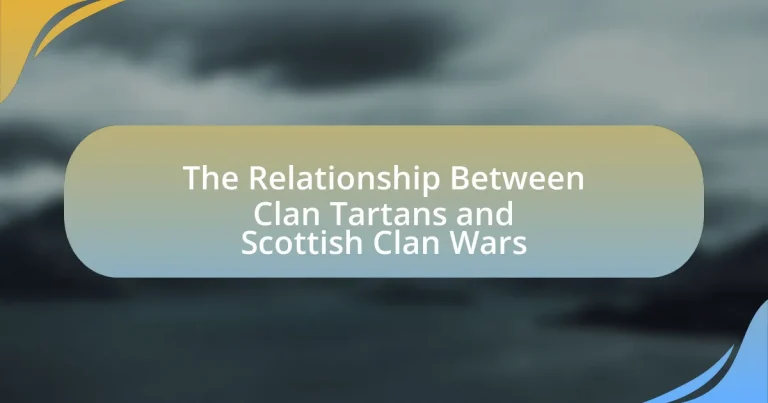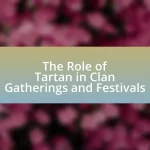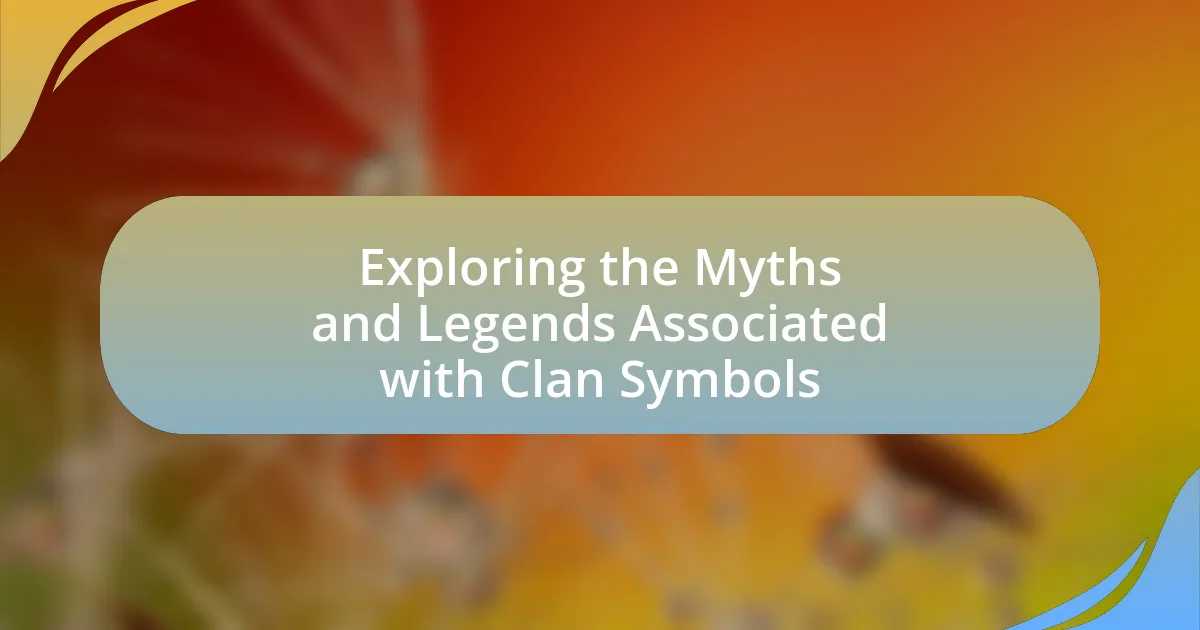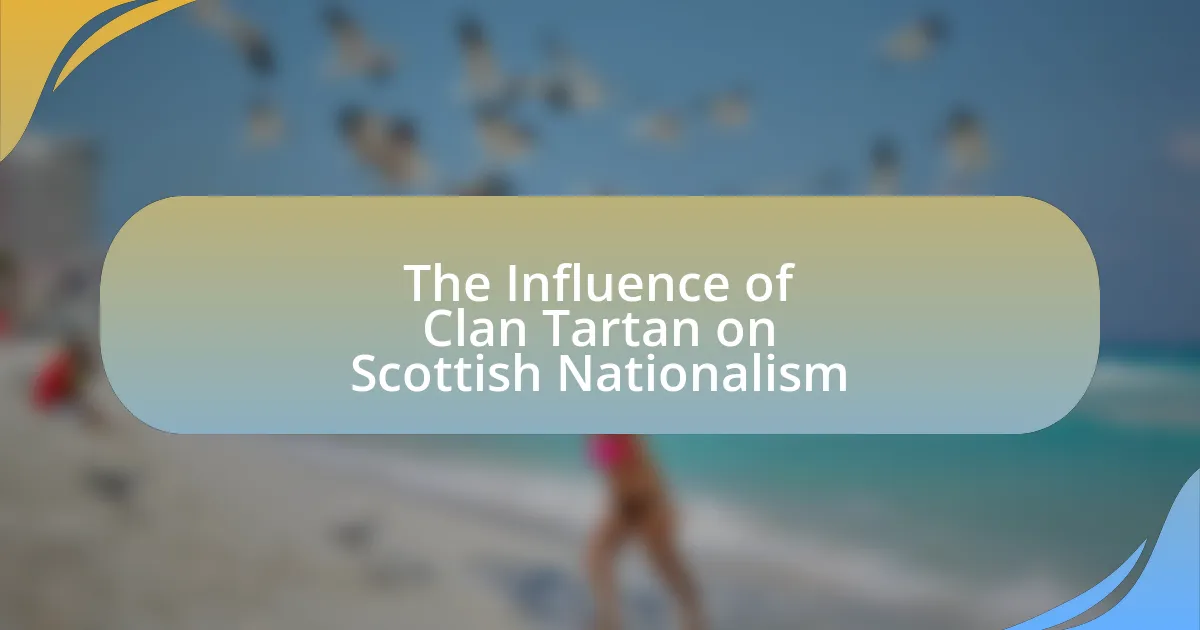Clan tartans are distinctive patterns that represent specific Scottish clans and play a significant role in the historical context of Scottish clan wars. These tartans served as visual symbols of loyalty and identity, allowing warriors to identify allies and enemies during conflicts, particularly during the 17th and 18th centuries, including the Jacobite uprisings. The article explores the origins of clan tartans, their evolution influenced by historical events, and their modern significance as symbols of Scottish heritage and identity. It also examines how tartans fostered unity among clans during warfare and continue to be celebrated in contemporary cultural events.
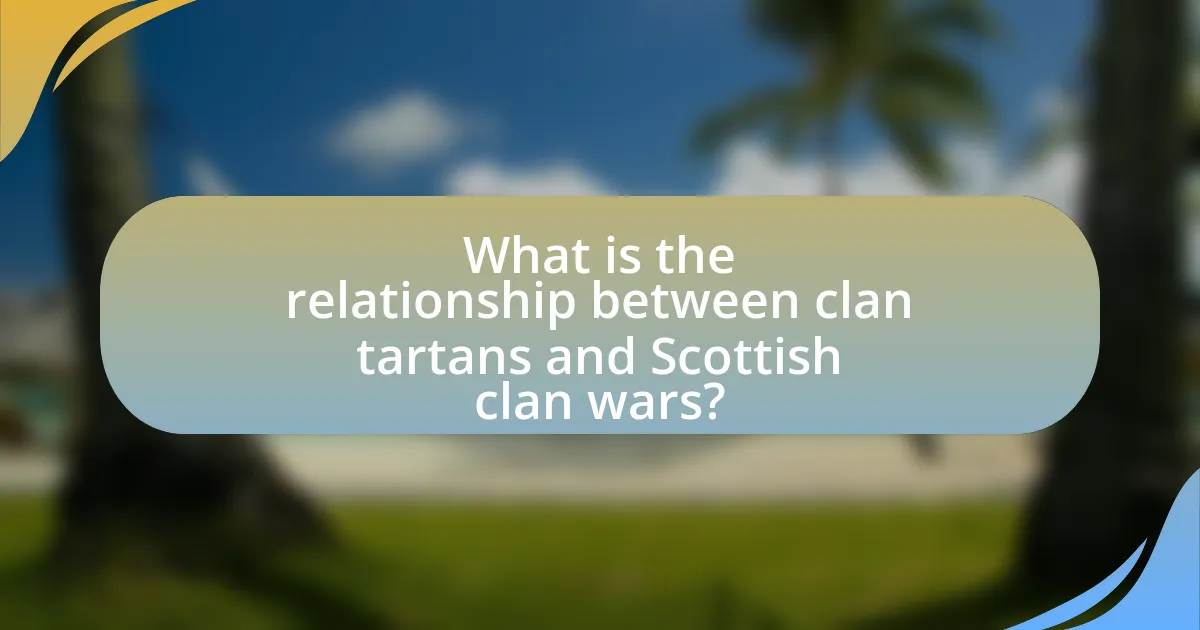
What is the relationship between clan tartans and Scottish clan wars?
Clan tartans serve as distinctive patterns representing specific Scottish clans, and their relationship to Scottish clan wars is rooted in identity and allegiance. During clan conflicts, tartans acted as visual symbols of loyalty, allowing warriors to identify allies and enemies on the battlefield. Historical records indicate that tartans became particularly significant during the 17th and 18th centuries, a period marked by intense clan rivalries and battles, such as the Jacobite uprisings. The use of tartans in these conflicts helped solidify clan identity and unity, as members donned their clan’s colors to demonstrate solidarity in warfare.
How did clan tartans originate in Scotland?
Clan tartans originated in Scotland as a means of identifying different clans and their members, particularly during the 16th century. The distinct patterns and colors of tartans were woven into woolen fabric, allowing clansmen to display their allegiance and heritage. Historical records indicate that the use of tartans became more formalized after the Jacobite uprisings in the 18th century, when tartans were associated with specific clans and became symbols of Scottish identity. The 1815 publication of “The Scottish Gael” by James Logan further solidified the connection between specific tartans and clans, providing a reference for their meanings and origins.
What historical events influenced the development of clan tartans?
The development of clan tartans was significantly influenced by historical events such as the Jacobite uprisings and the subsequent Acts of Proscription. The Jacobite uprisings, particularly those in 1715 and 1745, aimed to restore the Stuart monarchy and fostered a sense of clan identity among Scottish Highlanders. Following the defeat of the Jacobites at the Battle of Culloden in 1746, the British government enacted the Dress Act of 1746, which prohibited the wearing of tartan and other Highland dress. This act inadvertently solidified the association of specific patterns with clans, as families sought to preserve their identity through clandestine use of tartans. The revival of interest in Highland culture in the 19th century, spurred by figures like Sir Walter Scott, further popularized clan tartans, leading to their establishment as symbols of Scottish heritage.
How do clan tartans represent clan identity?
Clan tartans represent clan identity by serving as distinctive patterns that symbolize the heritage, lineage, and unity of a specific clan. Each tartan is associated with a particular clan, often reflecting its history, values, and geographical origins. For example, the MacLeod tartan features a unique color scheme and pattern that distinguishes it from others, reinforcing the sense of belonging among its members. Historically, during the Scottish clan wars, these tartans were not only a means of identification on the battlefield but also a way to foster loyalty and solidarity within the clan, as members would wear their tartan with pride, showcasing their allegiance and heritage.
Why are clan tartans significant in the context of Scottish clan wars?
Clan tartans are significant in the context of Scottish clan wars because they served as a visual identifier of clan allegiance and unity during conflicts. The distinct patterns and colors of tartans allowed warriors to recognize allies and enemies on the battlefield, fostering a sense of belonging and loyalty among clan members. Historical records indicate that during the Jacobite risings in the 18th century, tartans were prominently worn by clansmen, reinforcing their identity and purpose in the struggle for power and land. This use of tartans not only symbolized clan pride but also played a strategic role in warfare, as it helped to organize troops and maintain morale amidst the chaos of battle.
How did clan tartans serve as symbols during conflicts?
Clan tartans served as symbols during conflicts by visually representing allegiance and identity among Scottish clans. Each tartan pattern was unique to a specific clan, allowing warriors to identify themselves and their allies on the battlefield. Historical records indicate that during the Jacobite uprisings, for instance, tartans became a rallying point for clans, fostering unity and a sense of belonging among fighters. The use of tartans also served as a means of psychological warfare, as the sight of a rival clan’s colors could instill fear or provoke aggression. Thus, clan tartans functioned not only as markers of heritage but also as strategic tools in the dynamics of conflict.
What role did clan tartans play in unifying clans during wars?
Clan tartans served as a significant unifying symbol for clans during wars by providing a visual identity that fostered solidarity among members. The distinct patterns and colors of each clan’s tartan allowed warriors to easily identify allies on the battlefield, promoting cohesion and a sense of belonging. Historical evidence shows that during the Jacobite uprisings in the 18th century, clans rallied under their respective tartans, which not only distinguished them from opposing forces but also reinforced their collective identity and purpose in the fight for their rights and lands. This visual representation of clan loyalty was crucial in maintaining morale and unity during conflicts.
What are the different types of clan tartans associated with Scottish clans?
Scottish clans are associated with several types of clan tartans, primarily categorized into three main types: district tartans, clan tartans, and fashion tartans. District tartans represent specific geographical areas, clan tartans are unique to individual clans and often reflect their heritage, while fashion tartans are designed for contemporary use and may not have historical clan associations. The existence of these tartans is rooted in Scottish tradition, where each clan’s tartan serves as a symbol of identity and lineage, often used during clan gatherings and significant events.
How are clan tartans categorized?
Clan tartans are categorized primarily based on their association with specific Scottish clans, which reflects the historical and cultural ties between the tartan patterns and the clans they represent. Each clan typically has its own unique tartan, which is often linked to its heritage, history, and geographical location in Scotland. Additionally, tartans can be classified into categories such as ancient, modern, and weathered, which denote variations in color and dyeing techniques used over time. This categorization is supported by the Scottish Register of Tartans, which officially records and recognizes the distinct patterns associated with each clan, ensuring that the tartans maintain their cultural significance and authenticity.
What are the meanings behind specific clan tartans?
Clan tartans represent the identity and heritage of specific Scottish clans, with each pattern and color symbolizing various meanings tied to the clan’s history, values, and geographical origins. For example, the MacLeod tartan features bold yellow and black, reflecting the clan’s strength and connection to the Isle of Skye, while the Campbell tartan, with its green and blue hues, signifies loyalty and the clan’s association with the Highlands. Historically, these tartans were used to distinguish clans during conflicts, reinforcing clan unity and pride, as seen during the Jacobite uprisings when tartans became symbols of allegiance.
How did clan wars influence the evolution of tartan patterns?
Clan wars significantly influenced the evolution of tartan patterns by creating distinct designs that represented specific clans and their allegiances. During conflicts, clans adopted unique tartan patterns to identify themselves on the battlefield, fostering a sense of unity and pride among members. Historical records indicate that the use of tartans became more pronounced in the 17th and 18th centuries, as clans sought to differentiate themselves from rivals. The Battle of Culloden in 1746, for example, led to the formalization of clan tartans, as the British government sought to suppress Highland culture, inadvertently solidifying tartan as a symbol of Scottish identity. This historical context illustrates how clan wars directly shaped the development and recognition of tartan patterns as emblems of clan heritage.
What changes occurred in tartan designs due to clan conflicts?
Clan conflicts led to significant changes in tartan designs, primarily through the introduction of distinct patterns and colors to signify allegiance and identity. During periods of warfare, clans developed unique tartans to differentiate themselves from rivals, enhancing visibility on the battlefield. For instance, the Jacobite risings in the 18th century prompted clans to adopt specific patterns that represented their loyalty to the Jacobite cause, resulting in the creation of new tartans that incorporated colors and designs associated with their clan’s heritage. This evolution in tartan design not only served practical purposes in conflict but also solidified clan identity and unity amidst the turmoil of Scottish clan wars.
How did victories or defeats shape the use of tartans?
Victories and defeats significantly influenced the use of tartans by clans in Scotland, as these outcomes often dictated the social and political status of clans. Following a victory, clans would adopt and display specific tartans to symbolize their triumph and assert their dominance, reinforcing clan identity and unity. For example, after the Battle of Culloden in 1746, the British government banned many tartans to suppress Highland culture, which led to a resurgence of tartan as a symbol of resistance and pride among clans. Conversely, defeats often resulted in the loss of land and power, leading clans to either abandon their traditional tartans or adopt new ones to signify a change in status or allegiance. The historical context of these events illustrates how the outcomes of clan wars directly shaped the adoption, modification, and significance of tartans within Scottish culture.
What is the modern significance of clan tartans in relation to Scottish heritage?
Clan tartans hold significant modern relevance as symbols of Scottish heritage, representing identity, lineage, and cultural pride. In contemporary society, these distinctive patterns are often worn during national celebrations, family gatherings, and cultural events, reinforcing connections to ancestral roots. The resurgence of interest in Scottish culture, particularly following the Scottish Parliament’s establishment in 1999, has led to a revival of traditional practices, including the wearing of clan tartans. This cultural renaissance is evidenced by the increasing popularity of Highland games and festivals, where tartans serve as visual markers of clan affiliation and unity. Additionally, the global Scottish diaspora actively embraces tartans, fostering a sense of belonging and continuity among Scots worldwide.
How do contemporary Scottish clans use tartans today?
Contemporary Scottish clans use tartans today primarily as symbols of identity and heritage. Clans often wear their specific tartans during cultural events, weddings, and clan gatherings, reinforcing their connection to ancestral lineage. The Scottish Register of Tartans, established in 2008, officially recognizes these patterns, ensuring that clans can maintain their unique designs and promote their historical significance. This practice not only fosters a sense of community among clan members but also serves to educate the public about Scotland’s rich cultural history.
What role do clan tartans play in cultural celebrations and events?
Clan tartans serve as significant symbols of identity and heritage during cultural celebrations and events. They represent specific clans, allowing individuals to express their lineage and connection to Scottish history. For instance, during events like Highland Games and clan gatherings, participants often wear their clan tartans to showcase unity and pride, reinforcing social bonds within the community. Historically, tartans have been used to distinguish clans during conflicts, but in contemporary settings, they foster a sense of belonging and cultural continuity, as evidenced by their prominent display in parades and festivals celebrating Scottish culture.
How can understanding the relationship between clan tartans and Scottish clan wars enhance cultural appreciation?
Understanding the relationship between clan tartans and Scottish clan wars enhances cultural appreciation by revealing the historical significance and identity tied to these symbols. Clan tartans served as identifiers for Scottish clans during conflicts, fostering a sense of belonging and unity among members. For instance, during the Jacobite risings in the 18th century, specific tartans were worn by clansmen to signify allegiance, which played a crucial role in battles and clan loyalty. This connection between tartans and historical events allows individuals to appreciate the depth of Scottish heritage, as each tartan tells a story of lineage, pride, and the struggles faced by clans throughout history.
What resources are available for learning more about clan tartans and their history?
Books, websites, and museums serve as valuable resources for learning about clan tartans and their history. Notable books include “Scottish Tartans: A Complete Guide” by Ian Campbell, which details various tartans and their clan associations. Websites like the Scottish Tartans Authority provide extensive databases of tartans along with historical context. Additionally, museums such as the National Museum of Scotland offer exhibitions and artifacts related to tartan history, showcasing its significance in Scottish culture and clan identity.
How can individuals engage with Scottish heritage through clan tartans?
Individuals can engage with Scottish heritage through clan tartans by wearing, purchasing, or learning about the specific tartans associated with their ancestral clans. Clan tartans serve as a visual representation of Scottish identity and lineage, with each pattern historically linked to a particular clan. For example, the MacGregor tartan is recognized as a symbol of the MacGregor clan, which has roots dating back to the 14th century. By donning these tartans, individuals not only express their connection to their heritage but also participate in cultural events such as Highland games and clan gatherings, where tartans are prominently displayed. This engagement fosters a deeper understanding of Scottish history and the significance of clan affiliations, particularly in the context of clan wars, where tartans were used to identify allies and enemies.
